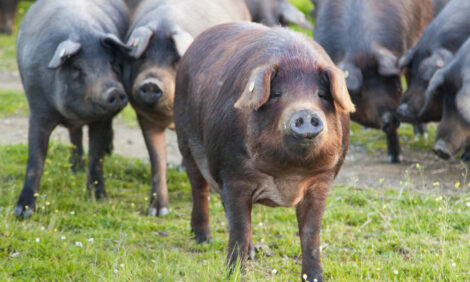



Higher Bacteria Count on Organic Pigs
COLUMBUS, US – While consumers are increasing demand for pork produced without antibiotics, more of the pigs raised in such conditions carry bacteria and parasites associated with food-borne illnesses, according to a new study.A comparison of swine raised in antibiotic-free and conventional pork production settings revealed that pigs raised outdoors without antibiotics had higher rates of three food-borne pathogens than did pigs on conventional farms, which remain indoors and receive preventive doses of antimicrobial drugs.
“Animal-friendly, outdoor farms tend to have a higher occurrence of Salmonella, as well as higher rates of parasitic disease,” said lead study author Wondwossen Gebreyes, associate professor of veterinary preventive medicine at Ohio State University.
 |
| Wondwossen Gebreyes |
More than half of the pigs on antibiotic-free farms tested positive for Salmonella, compared to 39 percent of conventionally raised pigs infected with the bacterial pathogen. The presence of the Toxoplasma gondii parasite was detected in 6.8 percent of antibiotic-free pigs, compared to 1.1 percent of conventionally raised pigs. And two naturally raised pigs of the total 616 sampled tested positive for Trichinella spiralis, a parasite considered virtually eradicated from conventional U.S. pork operations.
As long as pork is cooked thoroughly according to federal guidelines, the presence of these infectious agents in food animals should pose no risk to human health. The U.S. Department of Agriculture recommends that consumers cook fresh pork to an internal temperature of 160 degrees Fahrenheit. The pathogens generally do not cause illness in the animals.
Gebreyes won’t recommend one type of pork production practice over another.
“We are just doing the science and showing the results,” he said. “Does having an antibiotic-free and animal-friendly environment cause the re-emergence of historically significant pathogens? I think that is an extremely important question for consumers, policymakers and researchers to consider.”
The study is published in a recent issue of the journal Foodborne Pathogens and Disease.
On conventional farms, pigs remain indoors in ventilated barns and have free movement within pens. Antibiotics are added to their feed to promote growth and protect against infections, followed by a withdrawal period before slaughter to ensure the meat doesn’t contain any antibiotic residue.
On antibiotic-free farms, pigs are reared in open fields with free access to soil and water. They are given antibiotics only for treatment against active infections, and once sick pigs are treated, they are separated from the herds and no longer marketed as naturally raised pork.
The scientists tested pigs on farms in North Carolina, Ohio and Wisconsin. Of the total studied, 324 were raised in antibiotic-free systems and 292 lived on conventional farms. The researchers took blood samples to test for the presence of antibodies against bacterial and parasitic infections. The higher rates of infection on natural farms were consistent in all three geographic regions.
Of the three pathogens studied, the positive tests for the Trichinella roundworm surprised researchers the most. Gebreyes said federal inspectors might expect to find one positive test for the parasite among more than 14,000 pigs, so the two positive tests among 600 pigs were significant.
The infection resulting from this parasite, trichinellosis, has historically been associated with undercooked pork, but in the recent past, the parasite has been associated mostly with wild mammals. People with this infection typically experience diarrhea, vomiting, fatigue and fever first, followed by headaches, cough, and aching joints and muscle pains. The symptoms can last for months, and severe cases can be fatal, according to the Centers for Disease Control and Prevention.
Prescription drugs are available to treat the infection. The nearly 7 percent of naturally raised pigs infected with Toxoplasma, while a relatively small number, still represented a significantly higher infection rate than that found in the conventional herds.
Most people with a functioning immune system can resist symptoms associated with infection by Toxoplasma, which is considered most risky for pregnant women and those with compromised immune systems.
Salmonella is a common cause of food-borne illness, typically causing diarrhea, fever and abdominal cramps that resolve within a week and rarely require treatment in healthy people. More than 1 million people are infected by Salmonella in the United States each year, according to the World Health Organization.
Gebreyes noted that routine antibiotic use does not fully prevent the occurrence of Salmonella bacteria even in conventional pig herds, as shown by the 39 percent of those pigs in this study that tested positive for the pathogen. By comparison, 54 percent of antibiotic-free pigs tested positive for Salmonella.
“The advantage of using antibiotics is to prevent these infections from occurring. The disadvantage is it appears to create a favorable environment for strains of the bacteria that are resistant to antibiotics,” he said. “On the other hand, when antibiotics are not used, the pigs tend to get less resistant bugs, but higher rates of the common bacteria of food safety concern. The prevalence of Salmonella was significantly higher in the antibiotic-free herd than in the conventional herd. That could cause concern down the road about eating this product.”
The researchers theorized that naturally raised pigs’ exposure to moisture, vegetation and other animal species could contribute to their higher rates of pathogens. This study is part of a comprehensive examination of food safety issues related to pork production that includes testing pigs for a broader range of disease-causing organisms.






